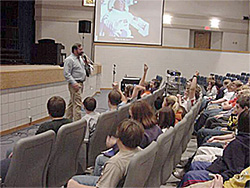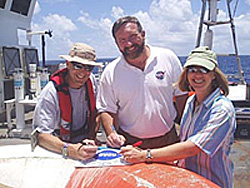Feature
Tom Nolan's Excellent Adventure
01.22.04
| Who are NASA's Earth Explorers? The elementary school student wondering how El Niño will affect tomorrow's weather. The scientist studying connections between ozone and climate change. And the farmer using satellite pictures to keep track of crops. All of these people are Earth Explorers -- they are all curious about the Earth system. This monthly series will introduce you to NASA Earth Explorers, young and old, with many backgrounds and interests. |

|
Nolan works at NASA's Jet Propulsion Laboratory (JPL) in Pasadena, Ca., as operations engineer for the Multi-angle Imaging SpectroRadiometer (MISR), an instrument onboard the Terra satellite. His may sound like a typical NASA job, but Nolan's journey since graduating with a degree in biology from the University of Southern California in 1977 has been anything but typical.
Primarily interested in marine biology, Nolan started out as a dolphin show trainer at a California theme park. Working closely with dolphins is exactly what Nolan had wanted to do, "but what I really enjoyed, as much as doing the show itself, was the interaction with the public," Nolan said. "All those questions about how the dolphins spin, jump, whiz and whir were just marvelous."
While Nolan's career has taken an unpredictable track, including stints as a fishing and wilderness guide in Alaska, a sporting goods shop owner in New Mexico, and a sales manager for a scuba manufacturing company in California, his underlying passion for communicating science has not wavered.
Joining NASA in 1998 as lead outreach coordinator for JPL's Earth Science Flight Projects office, where he conducted programs to inform the public about JPL's Earth science missions, allowed Nolan to combine his expertise in science with a desire to educate.
"I enjoy translating what is difficult for people to understand," said Nolan, who continues to be involved in outreach and education activities, even though his current job -- broadcasting commands to the MISR instrument and monitoring its overall health and safety -- is more technical in nature.

|
Nolan also speaks about Earth science topics and how NASA studies Earth from space as part of the Challenger Center for Space Science Education's Journey through the Universe program, which sends teams of NASA scientists and educators into communities to stimulate scientific awareness. The Challenger Center is a nonprofit education organization created in 1986 by the families of the astronauts lost during the Challenger space shuttle mission.
"The [program] is an excellent venue to truly affect a geographic area and build synergy where the whole community gets involved," Nolan said.
Nolan attributes his wide variety of positions and roles over the course of his career to a constant inner curiosity, as well as a good education. He also points out the importance of being able to adapt to different, sometimes unexpected situations and environments. For example, satellite oceanography -- the field that Nolan is now involved in -- did not even exist when he was in school. It wasn't until 1978 that NASA launched Seasat, the first satellite dedicated to studying Earth's oceans from space.
"Most kids in school are going to have careers in fields that haven't been invented yet," Nolan said. "The geoscience and engineering background is important, but equally important is the drive. If you have this internal drive where you 'gotta know,' NASA is a great place to be."
Coming in February: Earth Explorers celebrates African American History Month.
Related Resources
MISR
http://www-misr.jpl.nasa.gov
NOAA Teacher at Sea
http://www.tas.noaa.gov
Teacher at Sea Webcasts
http://www.tas.noaa.gov/cotas/videos
Challenger Center's Journey through the Universe
http://challenger.org/jttu